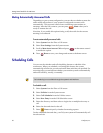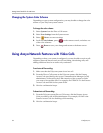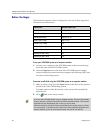
Getting Started Guide for the VSX Series
© Polycom, Inc. 41
Video Conferencing Tips
Read through these quick tips for ideas on how to optimize your video
conferencing experience. You'll find general tips for a better meeting, as well
as simple suggestions for improving video and audio quality, and for showing
documents.
Tips for Great Meetings
• Make sure that you have the video number(s) of the site(s) you want to call
or that the site(s) are listed in a directory.
• Set your camera presets before you start your call so that you can quickly
use them during the call. (You can set up to 100 near-site presets.
Depending on the system you call, you may also be able to use the presets
stored on the far-site system.)
• Add peripherals to your system to expand its use. For example, you can
add a VCR if you want to show a videotape, or add a Visual Concert VSX
or ImageShare II if you want to share data from a computer. Connect and
test your peripheral before any meeting.
Tips for Great Video
• Avoid wearing bright colors, all-light or all-dark clothing, or very “busy”
patterns (such as small checks or narrow stripes). Light pastels and muted
colors look the best on the screen.
• If there are windows in the room, close any drapes or blinds. Daylight is a
variable light source and can conflict with interior room lighting.
• Use natural gestures when you speak.
• When adjusting your camera, try to fill the screen as much as possible with
people rather than with the table, chairs, walls, lights, or the floor.
Tips for Great Audio
• Speak in your normal voice without shouting.
• Ask the people at the other site if they can hear you. Have them introduce
themselves so you can be sure that you can hear them.
• Mute the microphone before moving it during a meeting.
• Since the audio has a very slight delay, you may want to pause briefly for
others to answer you or to make comments.
• As with any meeting, try to limit side conversations.


















